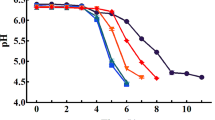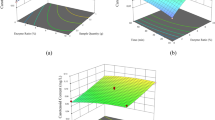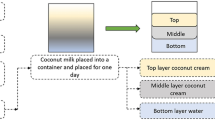Abstract
The aim of this study was to investigate the effects of tomato and garlic extracts on lipid oxidation in fish croquette during frozen storage. The fish for croquette was purchased from the main fish market in Antalya, Turkey. Commercial tomato and garlic extracts were added into the croquette formulation. Lipid quality of frozen croquettes was analyzed at monthly intervals. There was no difference in free fatty acids and UV absorbance values of treatment groups. Treatment of tomato and garlic extracts kept oxidation at low levels. The results for thiobarbutiric acid, para-anisidine, and conjugated-diene values showed that tomato extract was the most effective in delaying lipid oxidation than garlic extract.
Similar content being viewed by others
References
Saldanha T, Benassi MT, Bragagnolo N. Fatty acid contents evolution and cholesterol oxides formation in Brazilian sardines (Sardinella brasiliensis) as a result of frozen storage followed by grilling. LWT-Food Sci. Technol. 41: 1301–1309 (2008)
Berra B, Montorfano G, Negroni M, Corsetto P, Rizzo AM. Biomarkers of long-chain PUFA ω-3 fatty acids and the human nutritional status. Lipid Technol. 21: 32–35 (2009)
Chen Y, Nguyen J, Semmens K, Beamer S, Jaczynski J. Chemical changes in ω-3-enhanced farmed rainbow trout (Oncorhynchus mykiss) fillets during abusive-temperature storage. Food Control 19: 599–608 (2008)
Huber GM, Rupasinghe HPV, Shahidi F. Inhibition of oxidation of ω-3 polyunsaturated fatty acids and fish oil by quercetin glycosides. Food Chem. 117: 290–295 (2009)
Sallam KI, Ishioroshi M, Samejima K. Antioxidant and antimicrobial effects of garlic in chicken sausage. LWT-Food Sci. Technol. 37: 849–855 (2004)
Leelarungrayub N, Rattanapanone V, Chanarat N, Gebicki JM. Quantitative evaluation of the antioxidant properties of garlic and shallot preparations. Nutrition 22: 266–274 (2006)
Bozin B, Mimica-Dukic N, Samojlik I, Goran A, Igic R. Phenolics as antioxidants in garlic (Allium sativum L., Alliaceae). Food Chem. 111: 925–929 (2008)
Lana MM, Tijskens LMM. Effects of cutting and maturity on antioxidant activity of fresh-cut tomatoes. Food Chem. 97: 203–211 (2006)
Lenucci MS, Cadinu D, Taurino M, Piro G, Dalessandro G. Antioxidant composition in cherry and high-pigment tomato cultivars. J. Agr. Food Chem. 54: 2606–2613 (2006)
Slimestad R, Verheul M. Review of flavonoids and other phenolics from fruits of different tomato (Lycopersicon esculentum Mill.) cultivars. J. Sci. Food Agr. 89: 1255–1270 (2009)
Zanfini A, Corbini G, La Rosa C, Dreassi E. Antioxidant activity of tomato lipophilic extracts and interactions between carotenoids and α-tocopherol in synthetic mixtures. LWT-Food Sci. Technol. 43: 67–72 (2010)
Spanos GA, Wrolstad RE. Influence of processing and storage on the phenolic composition of Thompson seedless grape juice. J. Agr. Food Chem. 38: 1565–1571 (1990)
Re R, Pellegrini N, Proteggente A, Pannala A, Yang M, Rice-Evans C. Antioxidant activity applying an improved ABTS radical cation decolourization assay. Free Radical Bio. Med. 26: 1231–1237 (1999)
Bligh EG, Dyer WJ. A rapid method of total lipid extraction and purification. Can. J. Biochem. Physiol. 37: 911–917 (1959)
Lees R. Food Analysis: Analytical and Quality Control Methods for the Food Manufacturer and Buyer. Leonard Hill Books. London, UK. p. 245 (1975)
Tarladgis BG, Watts BM, Younathan MS, Dugan LJR. A distillation method for the quantitative determination of malonaldehyde in rancid foods. J. Am. Oil Chem. Soc. 37: 44–48 (1960)
IUPAC (International Union of Pure and Applied Chemistry). Standard Methods for the Analysis of Oils, Fats, and Derivates. 7th ed. Paquet C, Hautfenne A (eds). Blackwell Scientific Publications, Oxford, UK. pp. 143–144 (1987)
IUPAC (International Union of Pure and Applied Chemistry). Standard Methods for the Analysis of Oils, Fats, and Derivates. 7th ed. Paquet C, Hautfenne A (eds). Blackwell Scientific Publications, Oxford, UK. pp. 144–145 (1987)
Toor RK, Savage GP, Heeb A. Influence of different types of fertilisers on the major antioxidant components of tomatoes. J. Food Compos. Anal. 19: 20–27 (2006)
Chang C, Lin H, Chang C, Liu Y. Comparisons on the antioxidant properties of fresh, freeze-dried, and hot-air-dried tomatoes. J. Food Eng. 77: 478–485 (2006)
Queiroz YS, Ishimoto EY, Bastos DHM, Sampaio GR, Torres EAFS. Garlic (Allium sativum L.) and ready-to-eat garlic products: In vitro antioxidant activity. Food Chem. 115: 371–374 (2009)
Ozogul Y, Ozyurt G, Ozogul F, Kuley E, Polat A. Freshness assessment of European eel (Anguilla anguilla) by sensory, chemical, and microbiological method. Food Chem. 92: 745–751 (2005)
Schormüller J. Manual of Food Chemistry. Band III/2. Teil Springer-Verlag, Berlin, Germany. pp. 1482–1537 (1968)
Tokur B, Ozkutuk S, Atici E, Ozyurt G, Ozyurt CE. Chemical and sensory quality changes of fish fingers, made from mirror carp (Cyprinus carpio L., 1758), during frozen storage (−18°C). Food Chem. 99: 335–341 (2006)
Tang S, Kerry JP, Sheehan D, Buckley DJ, Morrissey PA. Antioxidative effect of tea cathechins on susceptibility of cooked red meat, poultry, and fish patties to lipid oxidation. Food Res. Int. 34: 651–657 (2001)
Kolanowski W, Jaworska D, Weissbrodt J. Importance of instrumental and sensory analysis in the assessment of oxidative deterioriation of ω-3 long-chain polyunsaturated fatty acid-rich foods. J. Sci. Food Agr. 87: 181–191 (2007)
Yerlikaya P, Gokoglu N. Inhibition effects of green tea and grape seed extracts on lipid oxidation in bonito fillets during frozen storage. Int. J. Food Sci. Tech. 45: 252–257 (2010)
Gokoglu N, Topuz OK, Yerlikaya P. Effects of pomegranate sauce on quality of marinated anchovy during refrigerated storage. LWTFood Sci. Technol. 42: 113–118 (2009)
Lugasi A, Losada V, Hovari J, Lebovics V, Jakoczi I, Aubourg S. Effect of pre-soaking whole pelagic fish in plant extract on sensory and biochemical changes during subsequent frozen storage. LWT-Food Sci. Technol. 40: 930–936 (2007)
Sanchez-Alonso I, Jimenez-Escrig A, Saura-Calixto F. Borderias AJ. Antioxidant protection of white grape pomace on restructured fish products during frozen storage. LWT-Food Sci. Technol. 41: 42–50 (2008)
Lopez A, Pique MT, Boatella J, Parcerisa J, Romero A, Ferran A, Garcia I. Influence of drying conditions on the hazelnut quality. Lipid oxidation. Drying Technol. 15: 965–977 (1997)
Weber J, Bochi VC, Ribeiro CP, Victorio AM, Emanuelli T. Effect of different cooking methods on the oxidation, proximate and fatty acid composition of silver catfish (Rhamdia quelen) fillets. Food Chem. 106: 140–146 (2008)
Author information
Authors and Affiliations
Corresponding author
Rights and permissions
About this article
Cite this article
Gokoglu, N., Yerlikaya, P., Topuz, O.K. et al. Effects of plant extracts on lipid oxidation in fish croquette during frozen storage. Food Sci Biotechnol 21, 1641–1645 (2012). https://doi.org/10.1007/s10068-012-0218-7
Received:
Revised:
Accepted:
Published:
Issue Date:
DOI: https://doi.org/10.1007/s10068-012-0218-7




